Filipino food has been getting a lot of attention lately. Restaurants like Kasama in Chicago and Musang in Seattle are helping bring Filipino food into the mainstream. Over the years, TV chefs like the late great Anthony Bourdain and Andrew Zimmern have done their part in promoting Filipino food as well.
Even if you’ve never been to the Philippines, you’ve probably heard of Filipino dishes like pork sisig and adobo. Bourdain called Filipino lechon “the best pig ever” while balut – that weird Filipino dish consisting of a developing duck embryo – is on everyone’s list of the world’s most bizarre foods.
But what about Filipino drinks? How many Filipino drinks can you actually name?
Filipino food is having its day in the sun but most people are still in the dark when it comes to Filipino drinks.
In this article, I’ll be shedding light on some of the most popular Filipino drinks to look for on your next trip to the Philippines.
Save This on Pinterest!
No time to read this article on popular Filipino drinks? Click on the save button and pin it for later!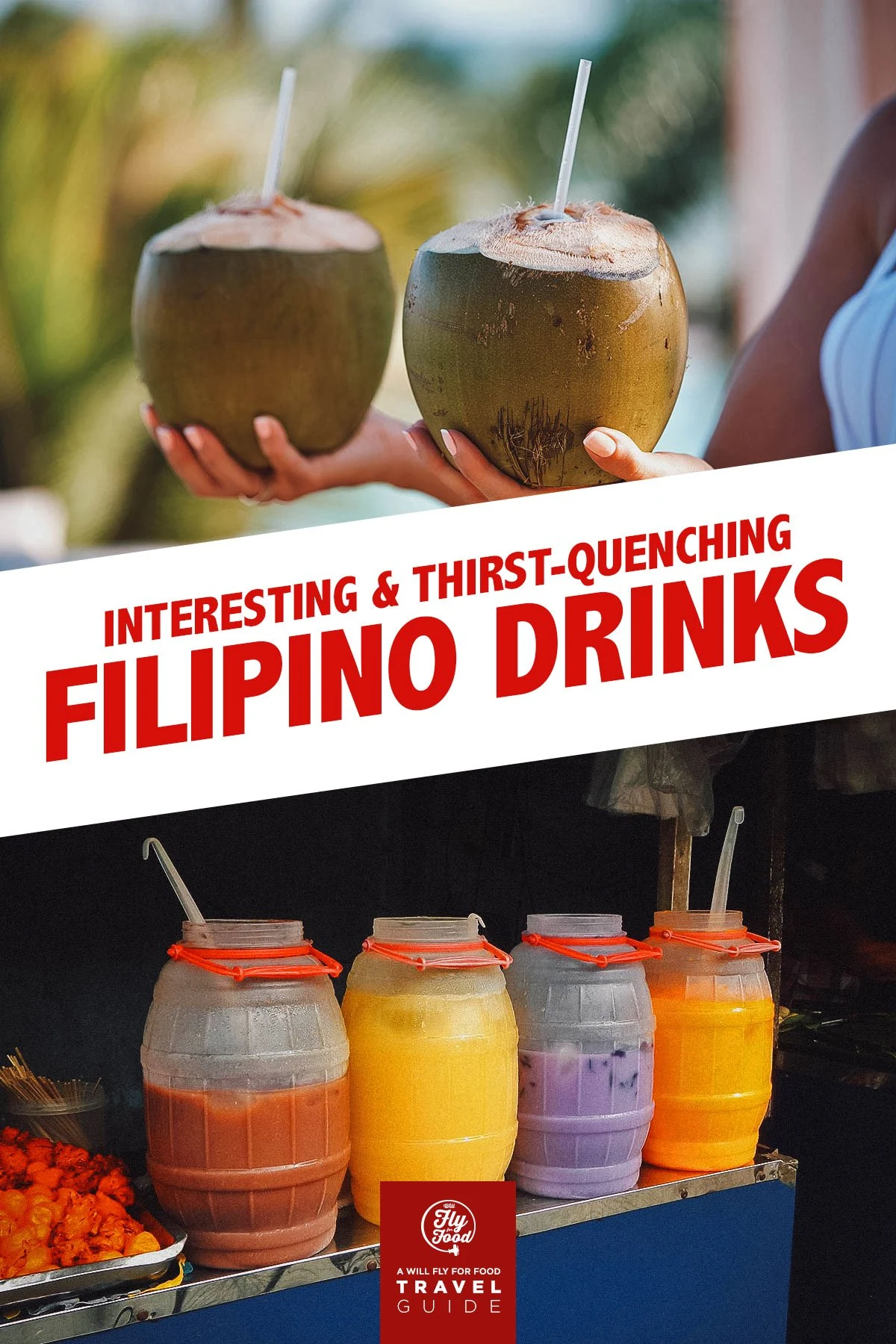
Photos by Judgefloro and AbElena
POPULAR FILIPINO DRINKS TO TRY IN THE PHILIPPINES
I’ve divided this article on Filipino drinks into two sections – non-alcoholic and alcoholic. Filipinos love to drink so no list of delicious Filipino drinks can ever be complete without mentioning a few of our favorite local brews.
NON-ALCOHOLIC DRINKS
1. Sago’t Gulaman
If you like street food, then it shouldn’t take long before you meet your first glass of sago’t gulaman in the Philippines. Short for “sago at gulaman”, it refers to a refreshing Filipino drink made with tapioca pearls (sago), gelatin (gulaman), brown sugar, and water.
Sago’t gulaman is commonly sold by Filipino street food vendors and shopping mall food court stalls. You’ll often find it on the menus of Filipino restaurants as well. Cold, sweet, and incredibly refreshing, it’s something that’s just as easily enjoyed for dessert as it is as a drink.
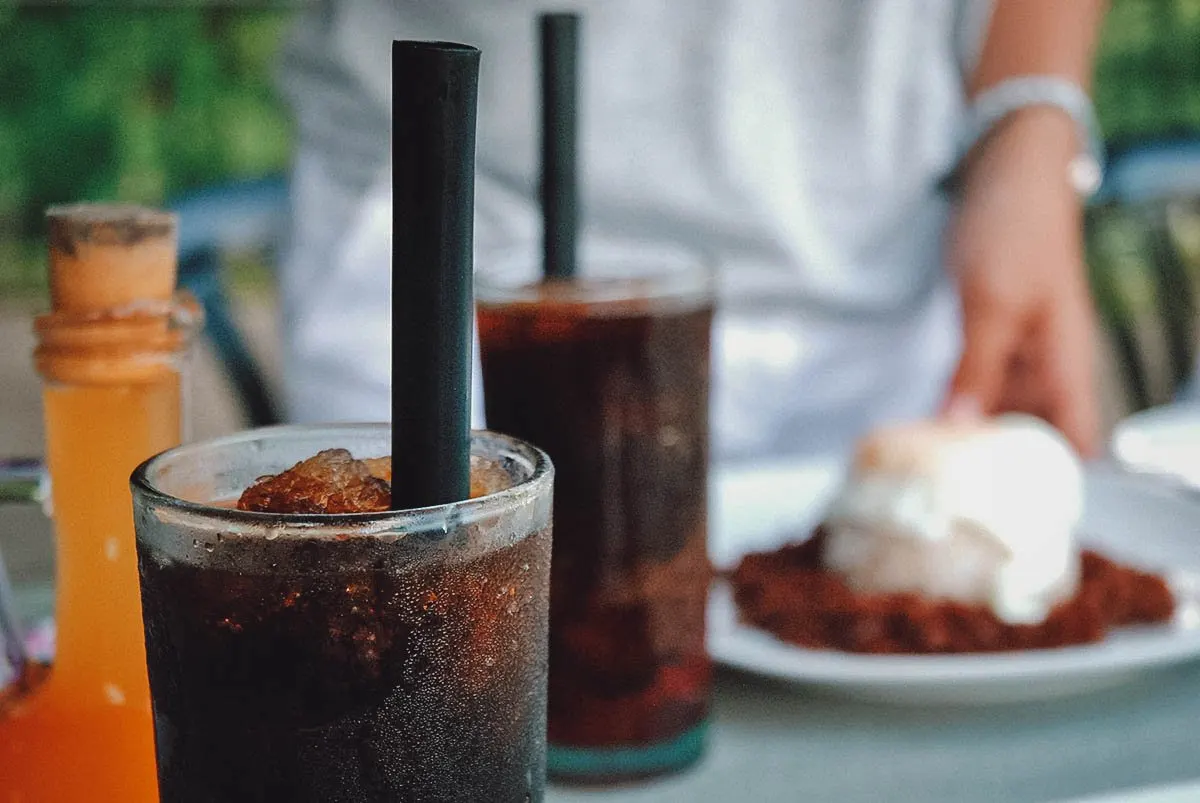
Photo by Jovin13
Sago’t gulaman and a few other drinks on this list belong to a family of chilled Filipino drinks called samalamig. They’re often made with jelly-like ingredients or chunks of fruit and are commonly sold in these plastic jugs by Filipino street vendors.
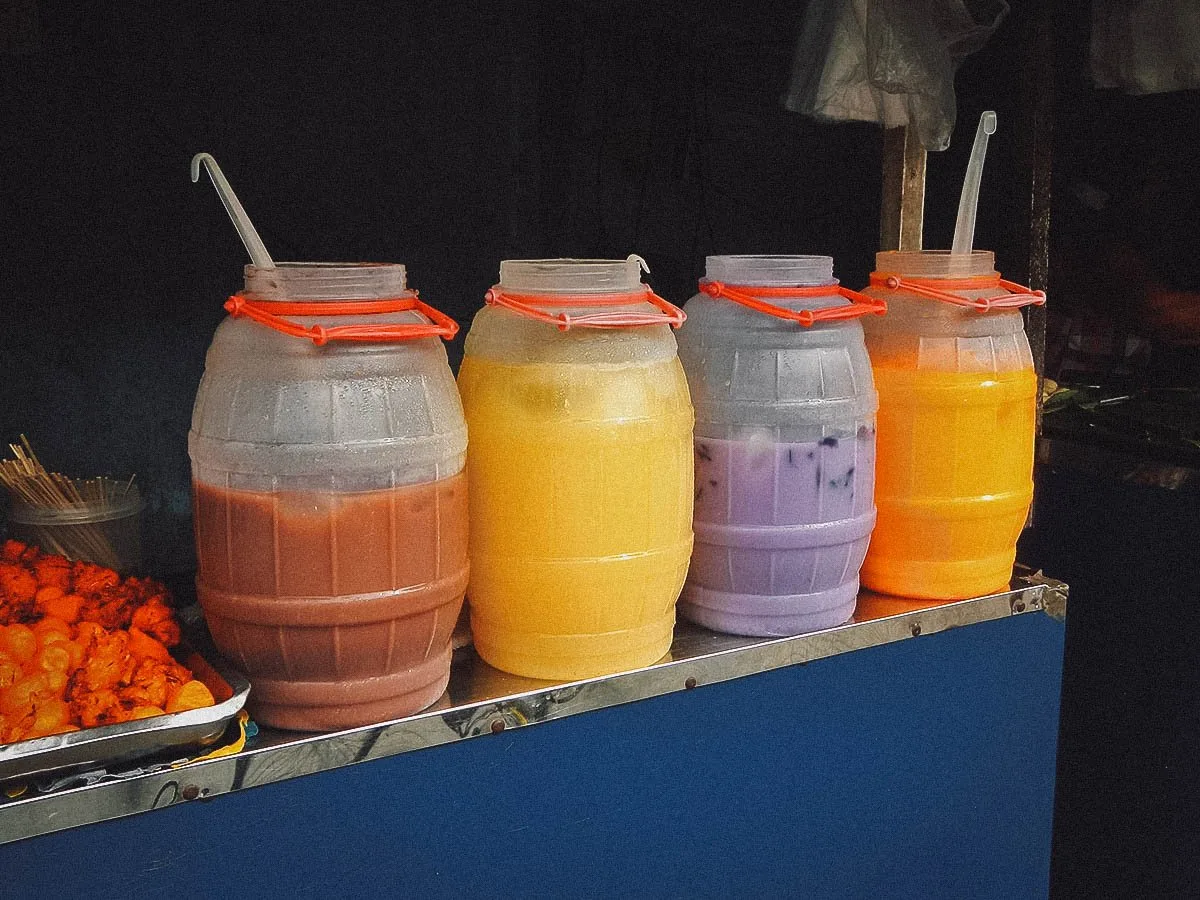
Judgefloro, CC0, via Wikimedia Commons / Cropped
2. Guinumis
Like sago’t gulaman, guinumis (or guinomis, ginumis) is one of my favorite Filipino drinks. It’s a type of samalamig that can be made in different ways, though the principal ingredients are gulaman, pinipig (toasted flattened glutinous rice), sugar, and water.
I was just talking to Ren about guinumis and the version I know contains just those four ingredients, but the guinumis she’s familiar with also has coconut milk. I searched online for recipes and many versions are also made with crushed ice and other ingredients, making it a variant of sorts of halo-halo. No matter what it’s made with, guinumis is delicious and a great way to quench your thirst on hot summer days.
As a side note, if you’ve never heard of halo-halo, it’s a crushed ice and condensed milk dessert served with a plethora of colorful ingredients. Some non-locals call it a drink but for me, it’s definitely a dessert – one of the best Filipino desserts ever!
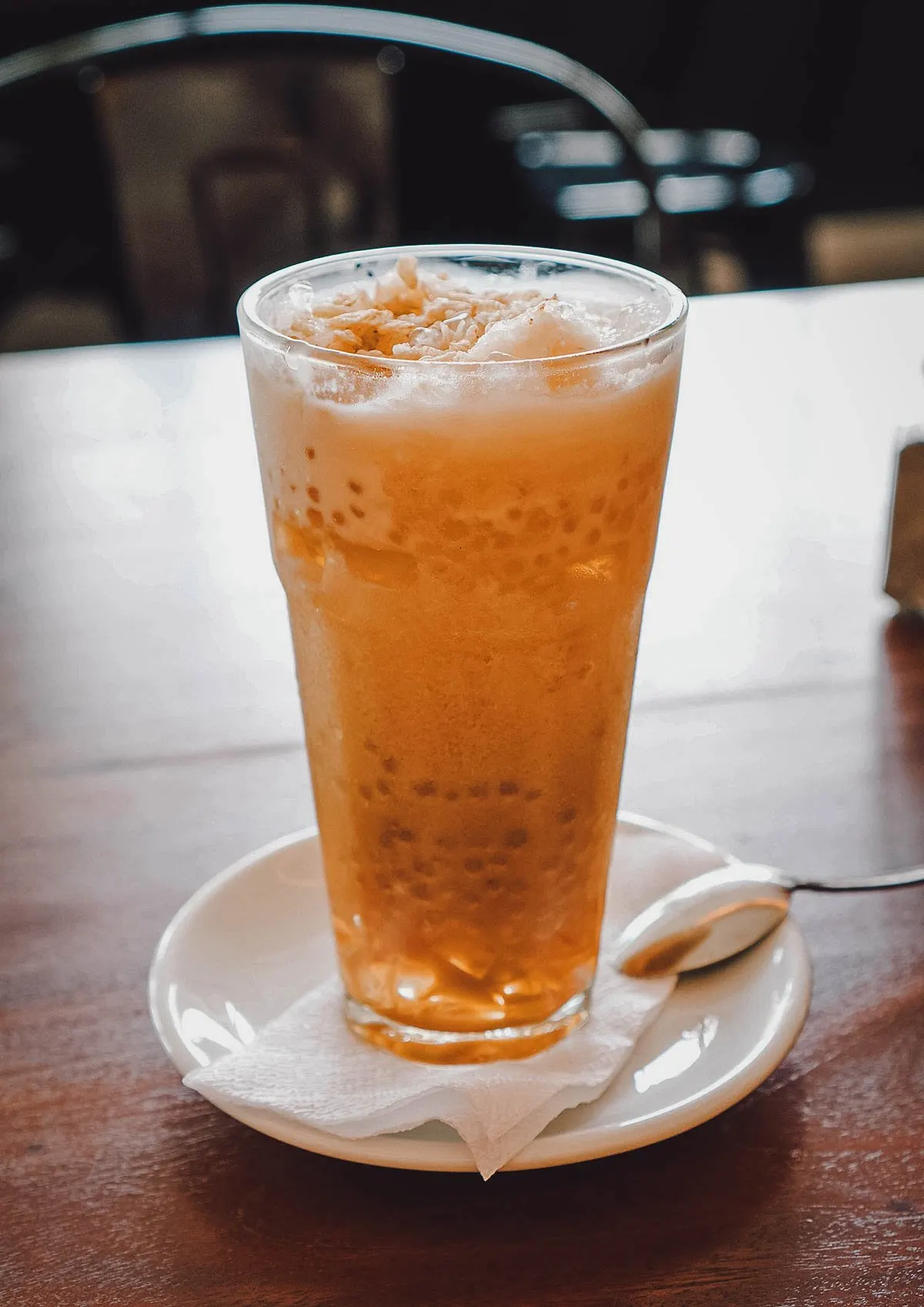
Photo by richardernestyap
3. Calamansi Juice
Calamansi is one of the most important Filipino fruits. Also known as calamondin, it’s a type of citrus hybrid that’s used in many Filipino dishes. It’s naturally very sour so it’s often used as an ingredient in marinades, dipping sauces, and of course, Filipino drinks.
The most well-known Filipino drink made from calamansi is calamansi juice, which is basically the local version of lemonade. It’s a simple drink made with just three ingredients – calamansi, sugar, and water.
High in Vitamin C, calamansi juice has a sweet and sour taste that’s both refreshing and invigorating.
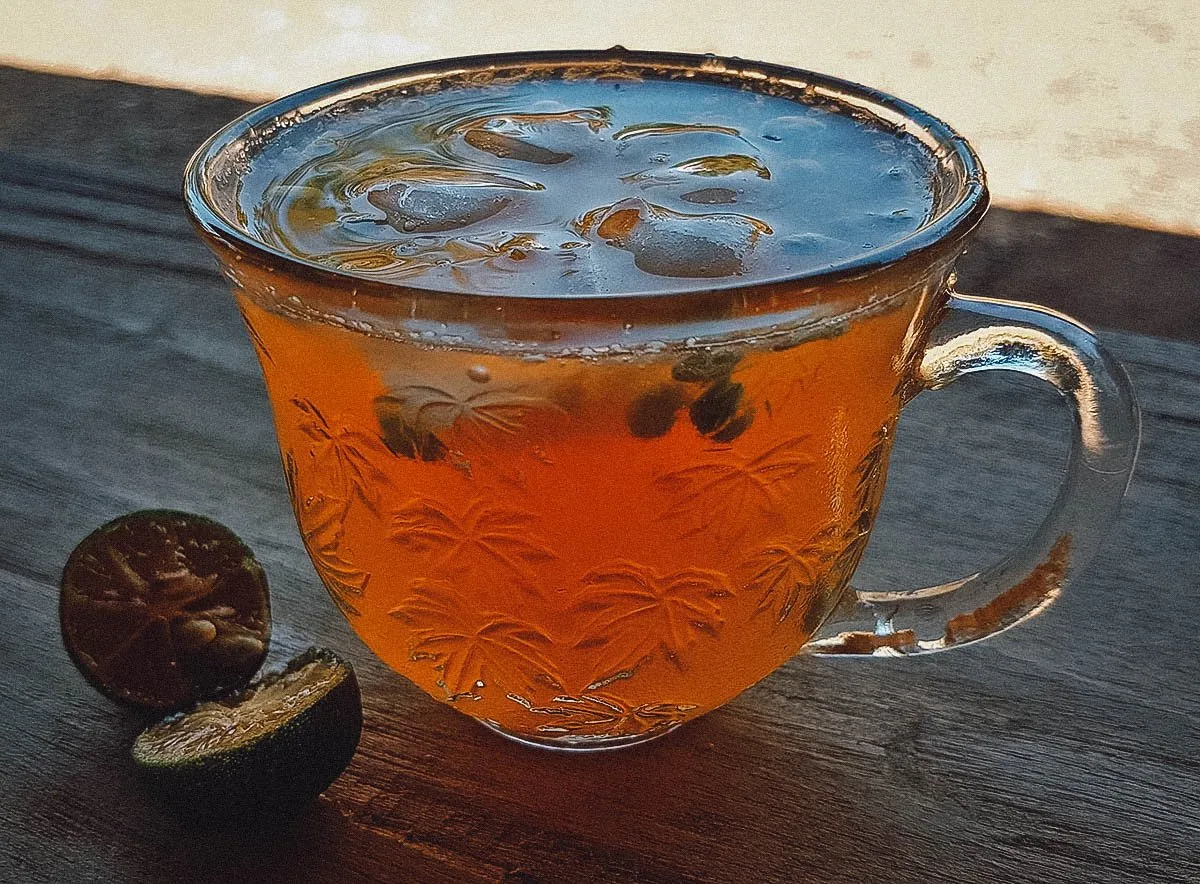
Obsidian Soul, CC0, via Wikimedia Commons
4. Mango Juice
The Philippines is known for its tropical fruits. Of all our local fruits, the mango is definitely king. We Filipinos are abundantly proud of our mangoes which we believe to be the best in the world.
Fresh Philippine mangoes – especially Guimaras mangoes – are to die for, but so is fresh mango juice. It can be made into juice with just fresh mangoes, sugar, and water, but it can also be turned into a shake when mixed with evaporated milk.
If you can’t get a hold of fresh Philippine mangoes to make mango juice, then you can buy Gina Mango Nectar from Amazon (affiliate link). I grew up on this stuff and loved it. It’s super thick so it’s best when thinned a little with ice.
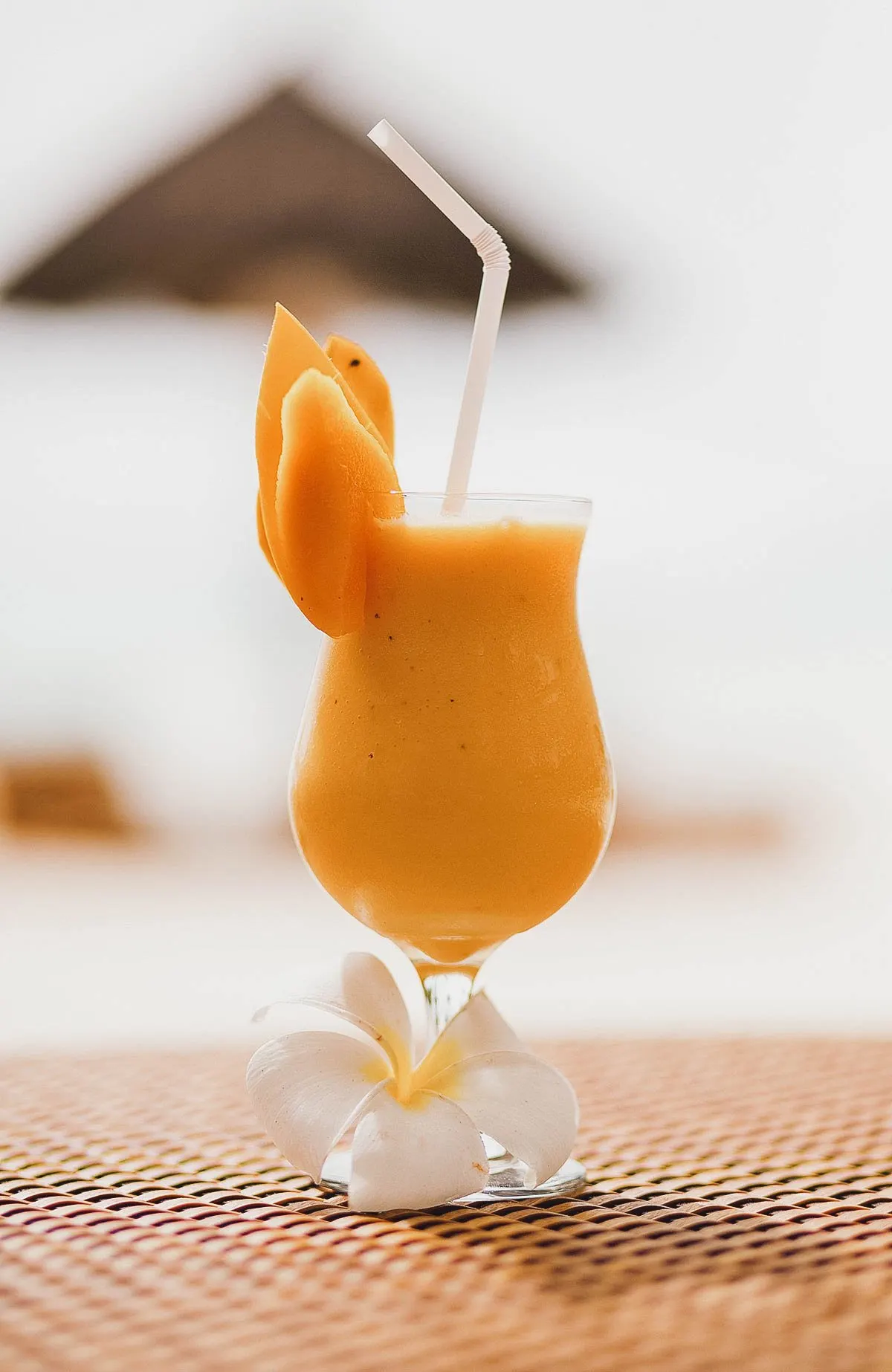
Photo by Ekaterina Pokrovsky
5. Melon (Cantaloupe) Juice
Melon juice is also one of my favorite types of Filipino drinks. It’s a popular samalamig made with slivers of cantaloupe mixed with sugar and water. It’s typically sold from those large plastic jugs pictured earlier in this article.
Sweet, cold, and refreshing, melon juice is one of my favorite types of Filipino fruit drinks because I enjoy chewing on the cantaloupe strips between sips of the drink.
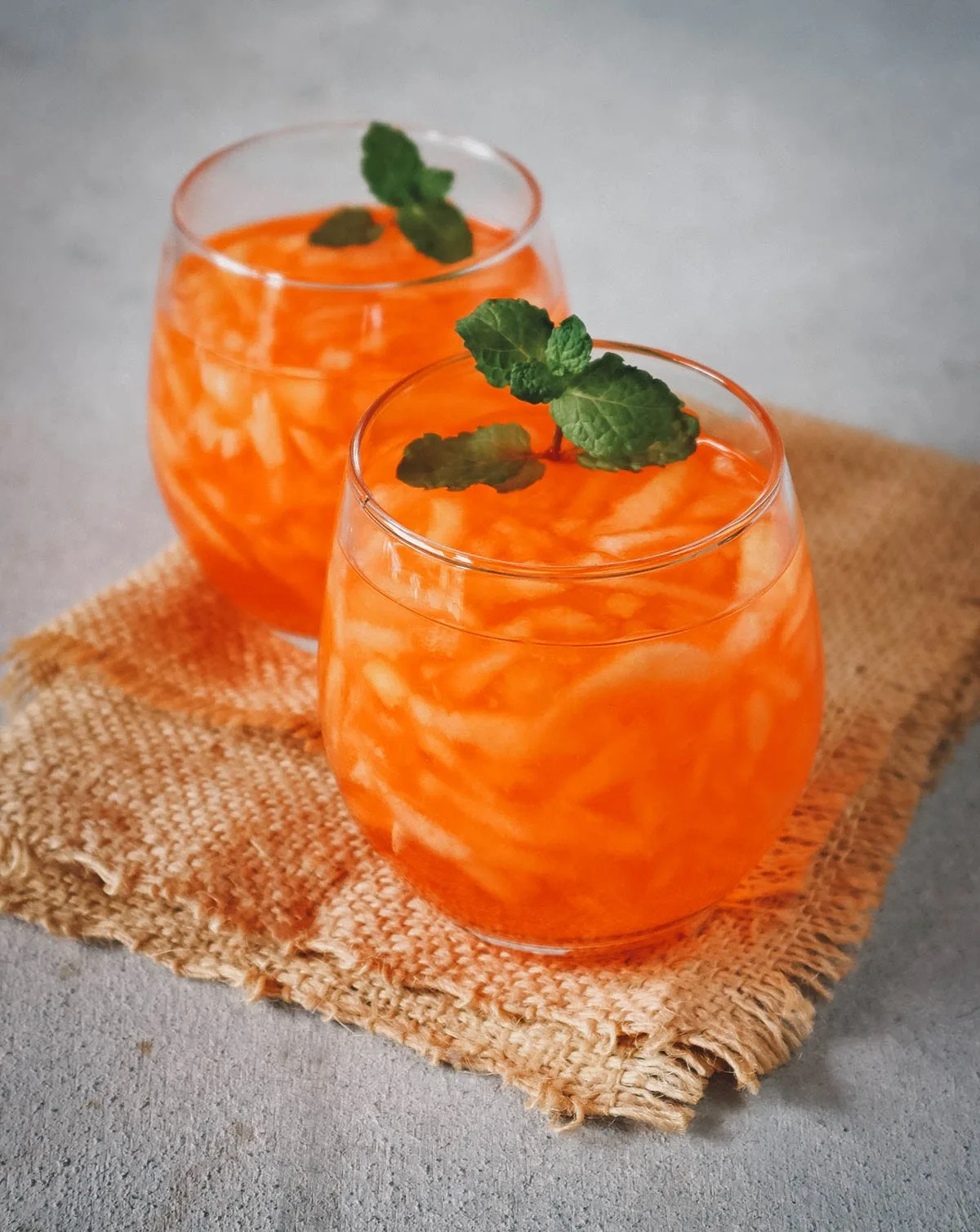
Photo by sri widyowati
6. Guyabano Juice
Guyabano juice is another popular fruit juice from the Philippines. It’s made from the guyabano tropical fruit, otherwise known as soursop.
Like the other fruit juices on this list, guyabano juice is made with just a few simple ingredients – fresh guyabano, sugar, water, and calamansi juice.
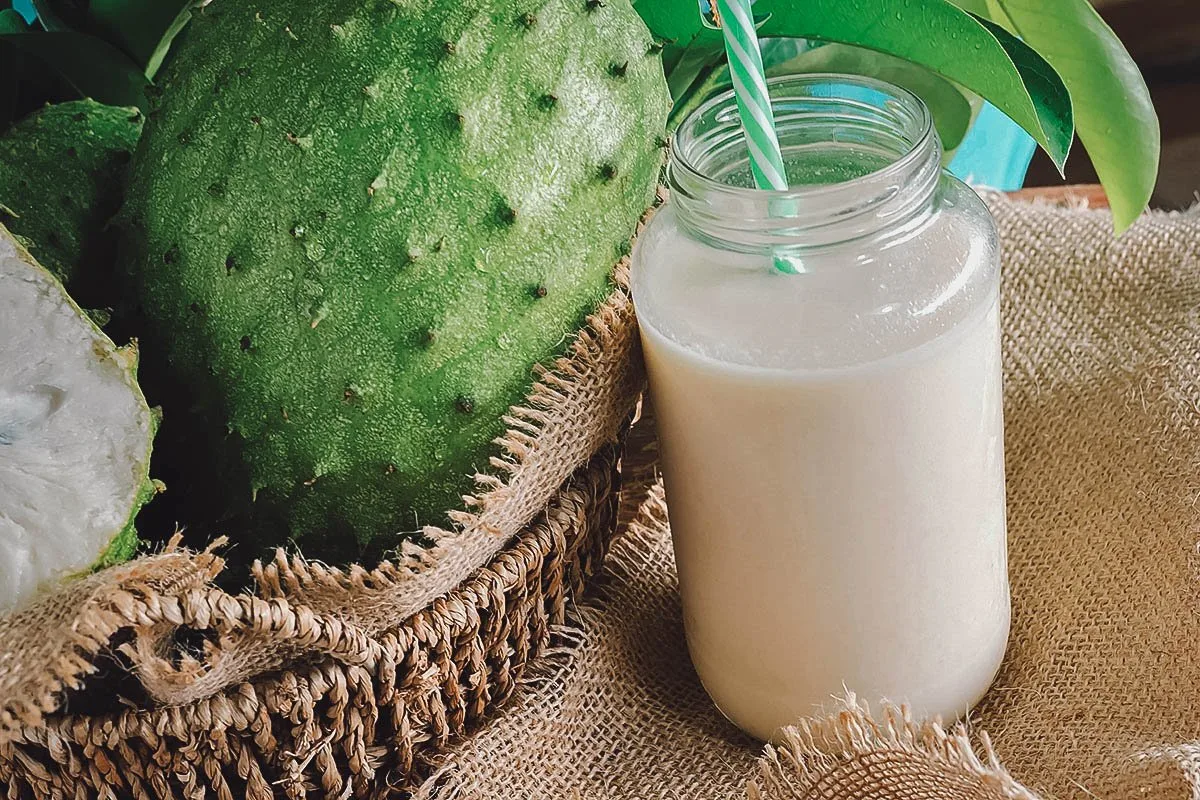
Photo by Francisco Rodriguez Herna
7. Buko Juice
No list of the most popular Filipino drinks can ever be complete without buko juice. Buko is the Filipino word for “coconut”.
The coconut tree is an extremely useful and versatile plant in the Philippines. Aside from being used for food and drinks, different parts of the tree and fruit can be used to make a variety of products like oil, rope, scrubbers, brooms, thatching, and furniture.
We went on a mezcal tour in Oaxaca and I told my guide that the coconut tree to Filipino culture is like the maguey plant to Mexican culture. It’s a life-giving plant that can be processed into a number of different things, including alcoholic drinks (lambanog, #11).
As versatile as it is, the most prized part of the coconut is its juice. It requires no processing or preparation. Just cut the buko open and you’ve got an instant beverage that you can enjoy straight from the shell with a straw. If you have a spoon, then you can scoop out the soft coconut flesh and eat it as a snack.
For me, nothing screams “tropical vacation” more than drinking buko juice from a coconut with a straw.
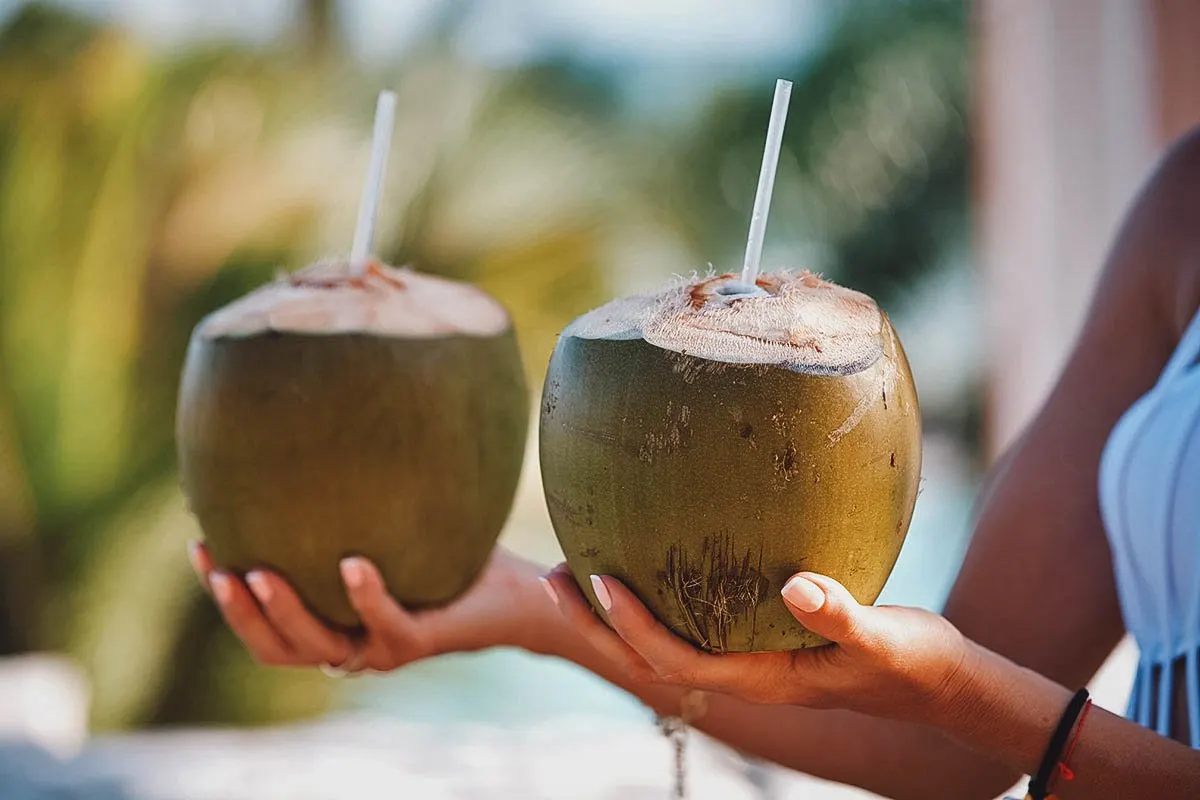
Photo by AbElena
8. Buko Pandan Drink
Buko pandan refers to a popular Filipino dessert made with shreds of young coconut meat, pandan (screwpine) leaves, coconut milk, and gulaman. When made with more liquid, it turns into a buko pandan drink – a refreshing beverage version of the classic dessert.
Buko pandan drinks are popular Filipino drinks that can be found at samalamig stands and Filipino dessert shops. Depending on the vendor, they can be made with additional ingredients as well like sago pearls, kaong (sugar palm fruit), nata de coco (coconut gel), and pinipig.
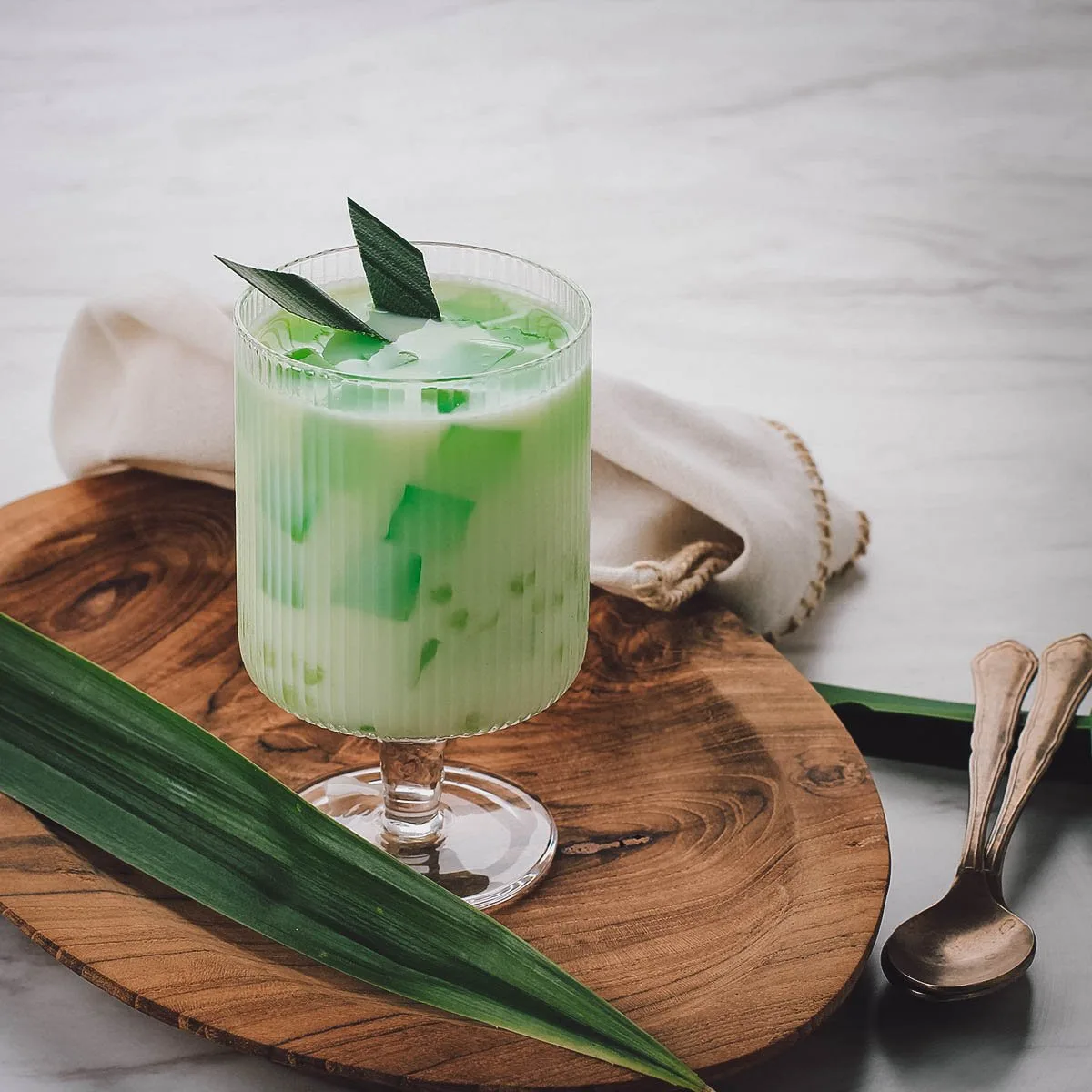
Photo by Ika Rahma H
9. Kapeng Barako
Batangas is known for its beaches. If you like coffee, then you’ll be pleased to learn that the province is known for its own varietal of coffee as well. Known as kapeng barako (“barako coffee”) or Batangas coffee, it’s a robust type of coffee with a fragrance reminiscent of aniseed.
Batangas is about a two-hour drive south of Manila so it’s easy to get barako coffee. You can find it at local Filipino coffee shops and supermarkets. Personally, we order bags of it online and enjoy it everyday while we’re in Manila.
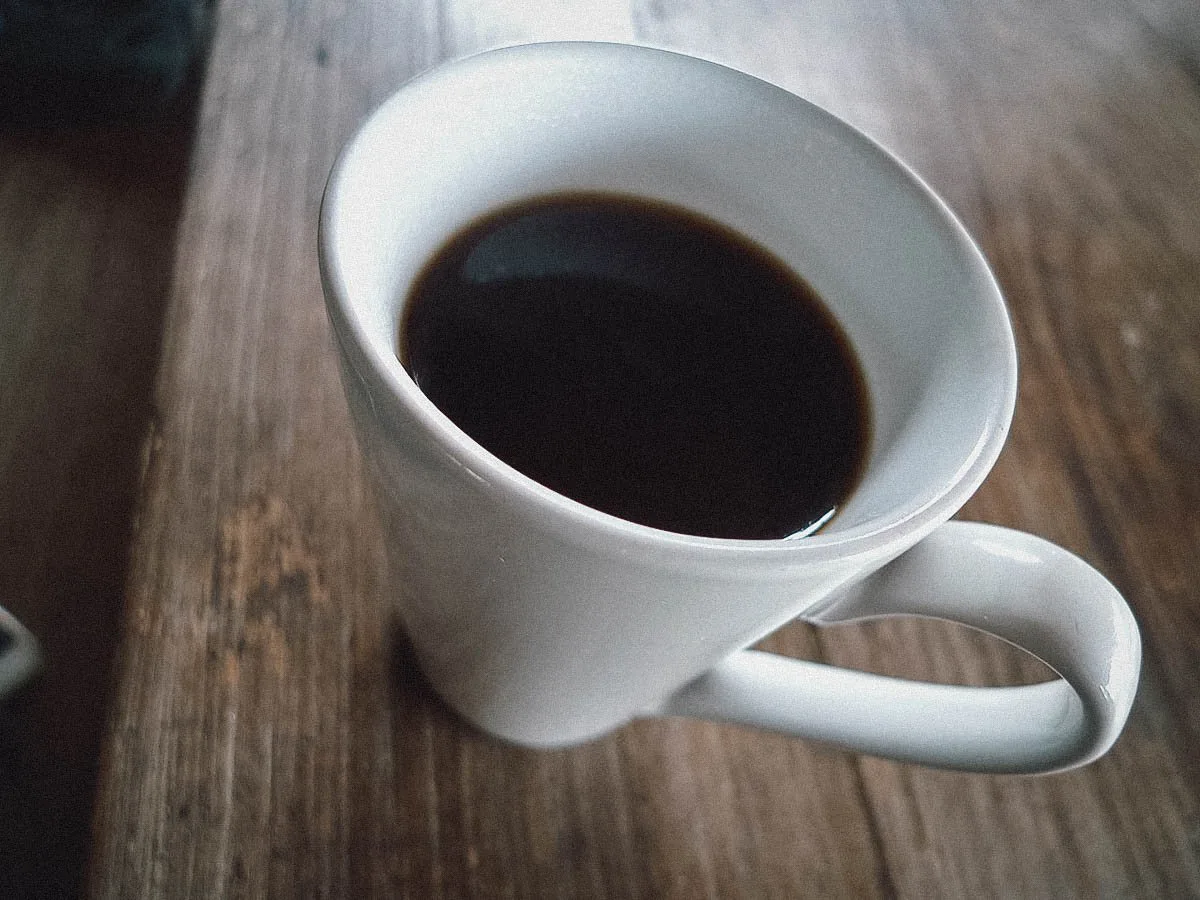
Yvette Tan, CC BY 2.0, via Wikimedia Commons
10. Salabat
If you have a sore throat, then there’s no better natural remedy than homemade ginger tea. Known locally as salabat, Filipino ginger tea is made with slivers of raw ginger boiled in water and sweetened with honey (or sugar) and calamansi juice.
Aside from soothing your sore throat or relieving a cough, salabat is also believed to enhance a person’s singing voice. A useful drink indeed in the land of karaoke.
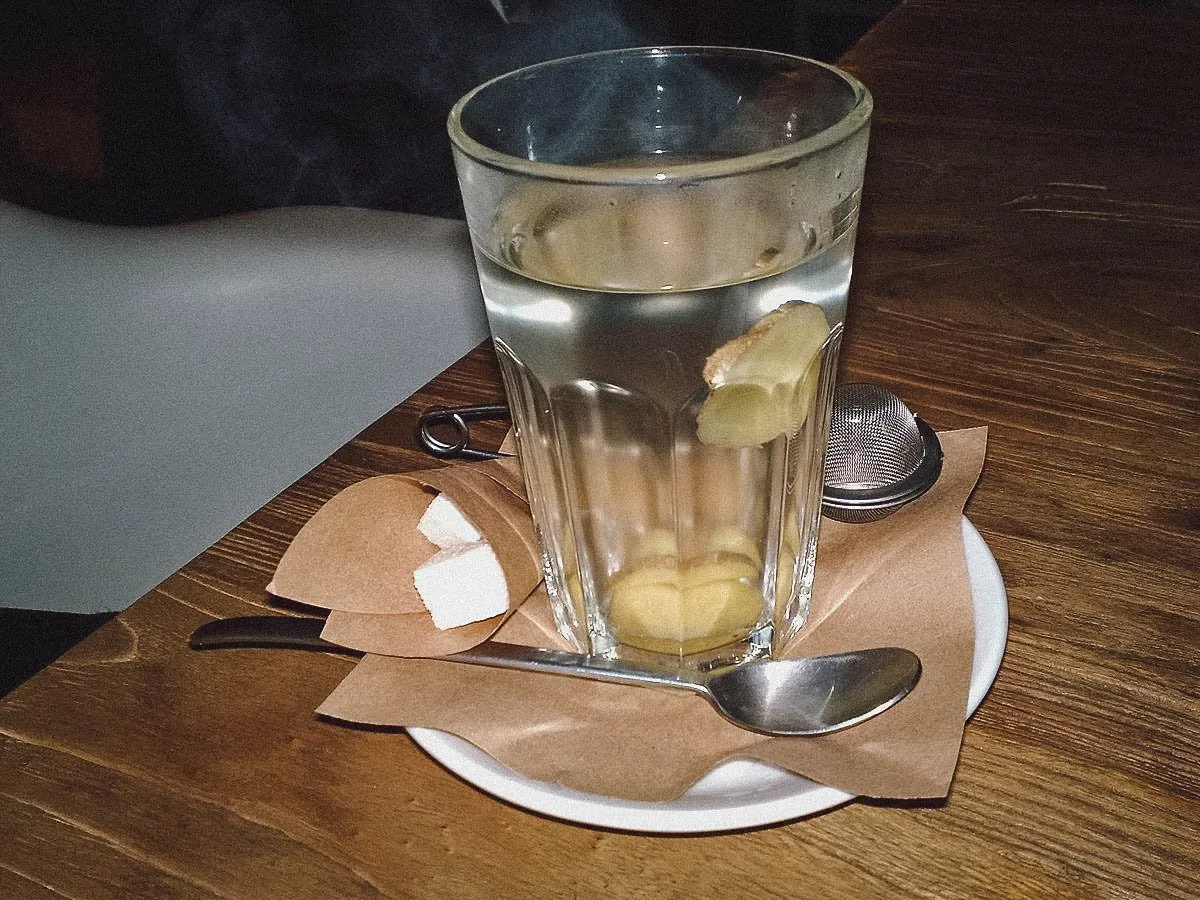
Gleb from St.Petersburg, Russia, CC BY 2.0, via Wikimedia Commons
ALCOHOLIC DRINKS
11. Lambanog
As previously described, coconuts can be made into a variety of alcoholic Filipino drinks, one of the most popular being lambanog. Also known as “coconut vodka” or “coconut wine”, it’s a potent type of alcoholic drink that contains about 40-45% abv.
Popular in the Luzon and Visayas regions of the Philippines, lambanog is made from tuba (#12) that’s been aged for at least 48 hours. It’s typically served pure though it can be flavored with raisins as well.
In recent years, colorful lambanog flavored with ingredients like mango, pineapple, orange, or strawberry has become increasingly popular, in an effort to appeal to younger generations.
12. Tuba
Lambanog may be more well-known but it wouldn’t be possible without tuba. Tuba refers to a family of Filipino alcoholic drinks made from fermented palm tree sap. Compared to lambanog, it has a relatively low alcohol content, about 2-4% abv.
If you’re familiar with Mexican tuba, then you may be surprised to learn that tuba arrived in Mexico by way of the Manila-Acapulco galleon trade. Filipino sailors brought coconuts and tuba to Mexico. Tuba became hugely popular and the same fermentation techniques were applied to the maguey plant, which helped create tequila and mezcal.
Today, a non-alcoholic version of tuba made from fresh coconut sap remains popular in some parts of Mexico, like Puerto Vallarta.
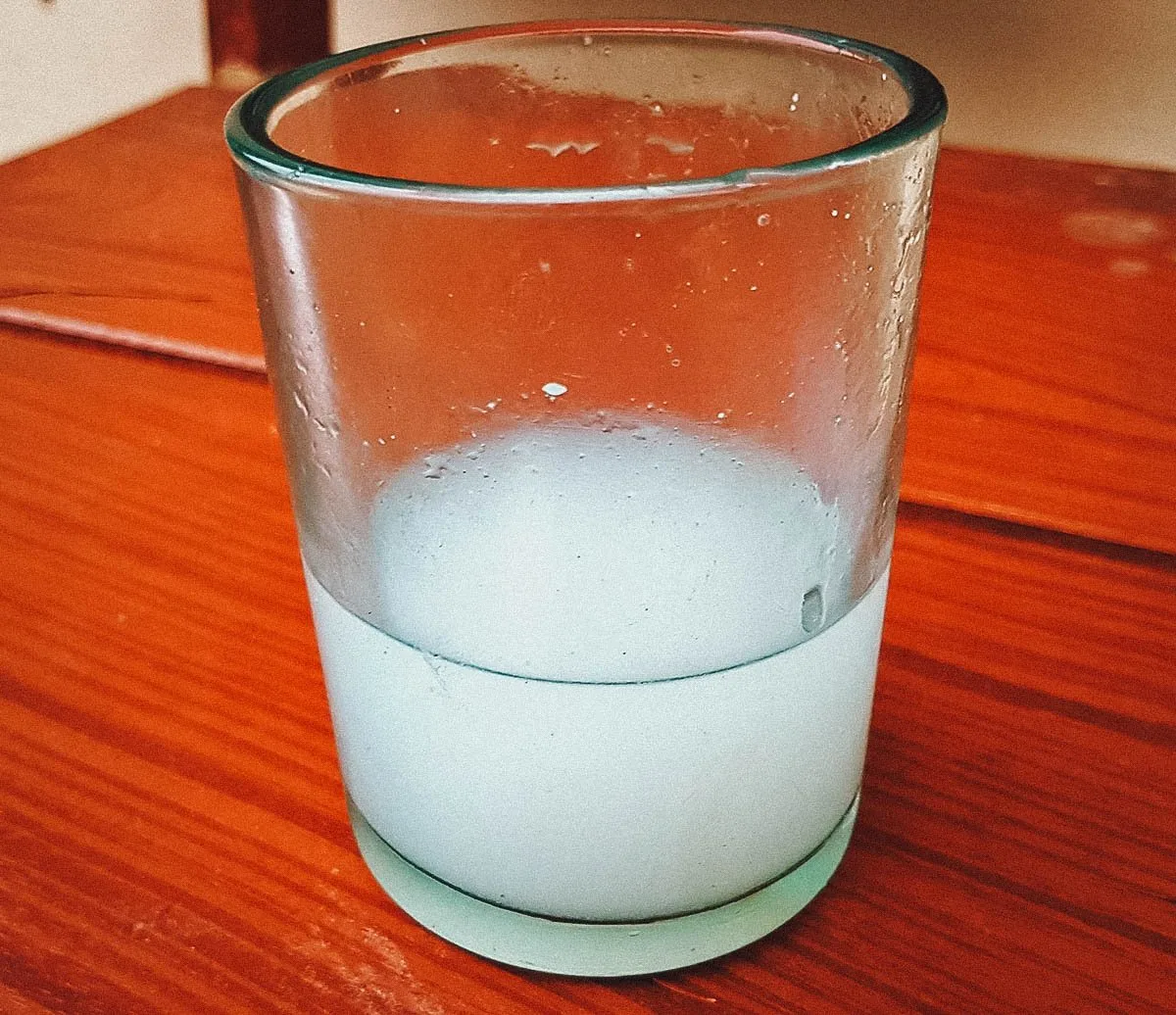
Obsidian Soul, CC0, via Wikimedia Commons
13. Bignay Wine
Bignay wine (or bugnay wine) refers to a fruity wine made from the berries of the bignay tree. You don’t see it too often in Manila but it’s a common sight in the provinces where it’s often sold alongside other types of fruit wine like strawberry wine and guyabano wine.
Bignay wine is deep red in color with a sweet taste and distinctly fruity aroma.
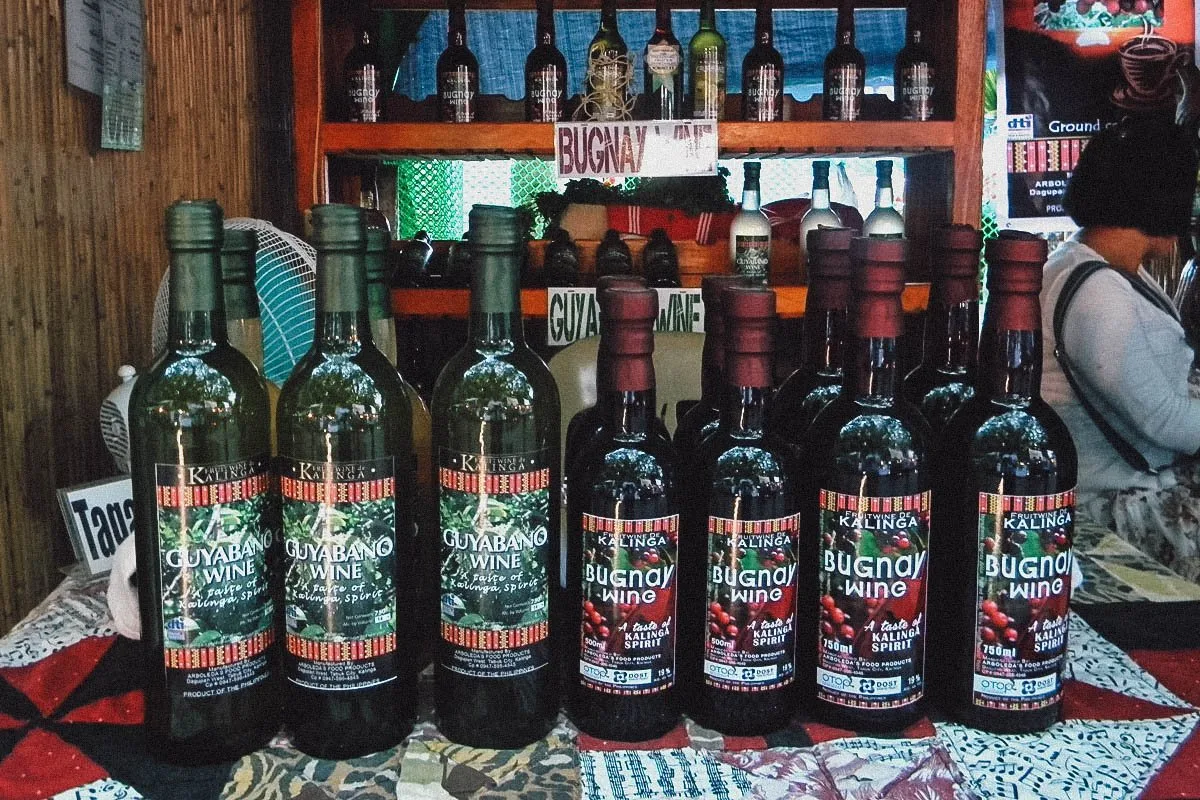
Philippine Information Agency, Public domain, via Wikimedia Commons
14. Tapuy (Fermented Rice Wine)
If you visit Banaue or Sagada, then you may want to try tapuy. It refers to a type of Filipino rice wine made with glutinous rice, ginger extract, and a powdered starter culture called bubod.
Like bugnay wine, you won’t find tapuy at most bars in Manila but it’s an important drink in Cordillera culture. Containing about 14% abv, it’s an alcoholic drink that’s traditionally consumed to celebrate special occasions like weddings, ceremonies, and festivals.
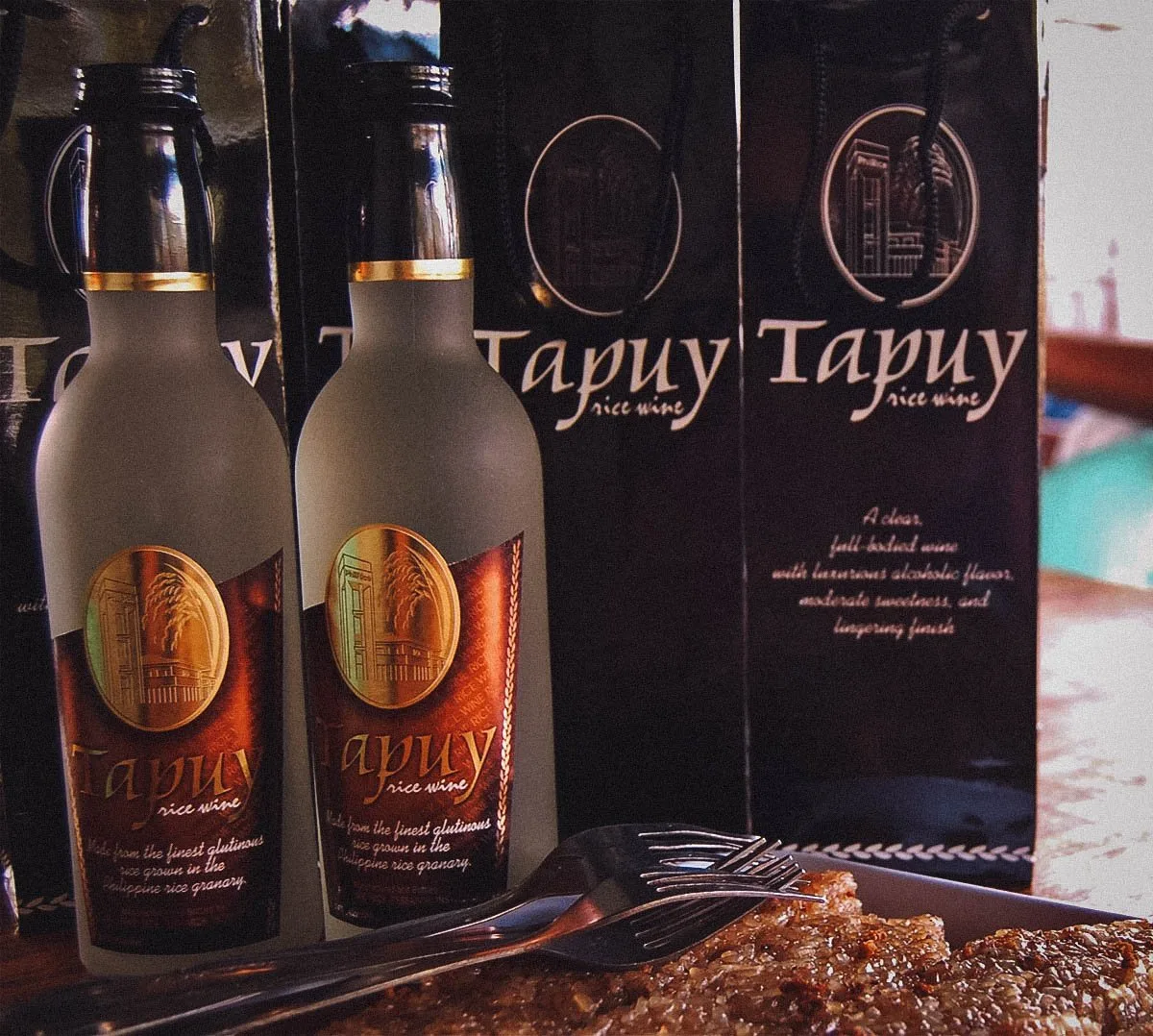
Shubert Ciencia, CC BY 2.0, via Wikimedia Commons / Cropped
15. Basi
Basi refers to a type of sugarcane wine produced in the Ilocos region of the Philippines.
Basi is made by crushing sugarcane stalks to extract the juice, which is then boiled in vats and left to cool in earthen jars called tapayan. Once cooled, ground glutinous rice and fruit bark are added to the juice. The earthen jars are sealed with banana leaves and left to ferment for several years.
Basi typically contains around 10-16% abv and can be made in two types – basing babae and basing lalaki. Basing babae (“women’s basi”) has a sweet taste and contains less alcohol while basing lalaki (“men’s basi”) is stronger and tastes more bitter.
16. San Miguel Beer
When it comes to Filipino alcoholic beverages, beer is king. Filipinos love all kinds of alcoholic drinks, but beer – especially San Miguel beer – reigns supreme. Even in the age of fancier craft beers, San Miguel beer continues to dominate the domestic beer market.
San Miguel Brewery produces several brands of Filipino beers, but the most popular are San Miguel Pale Pilsen (pictured below) and San Mig Light. Both contain about 5% abv but San Mig Light has just 100 calories.
Go to any bar in the Philippines and observe what people are drinking. I guarantee that most will be drinking either Pale Pilsen or San Mig Light.
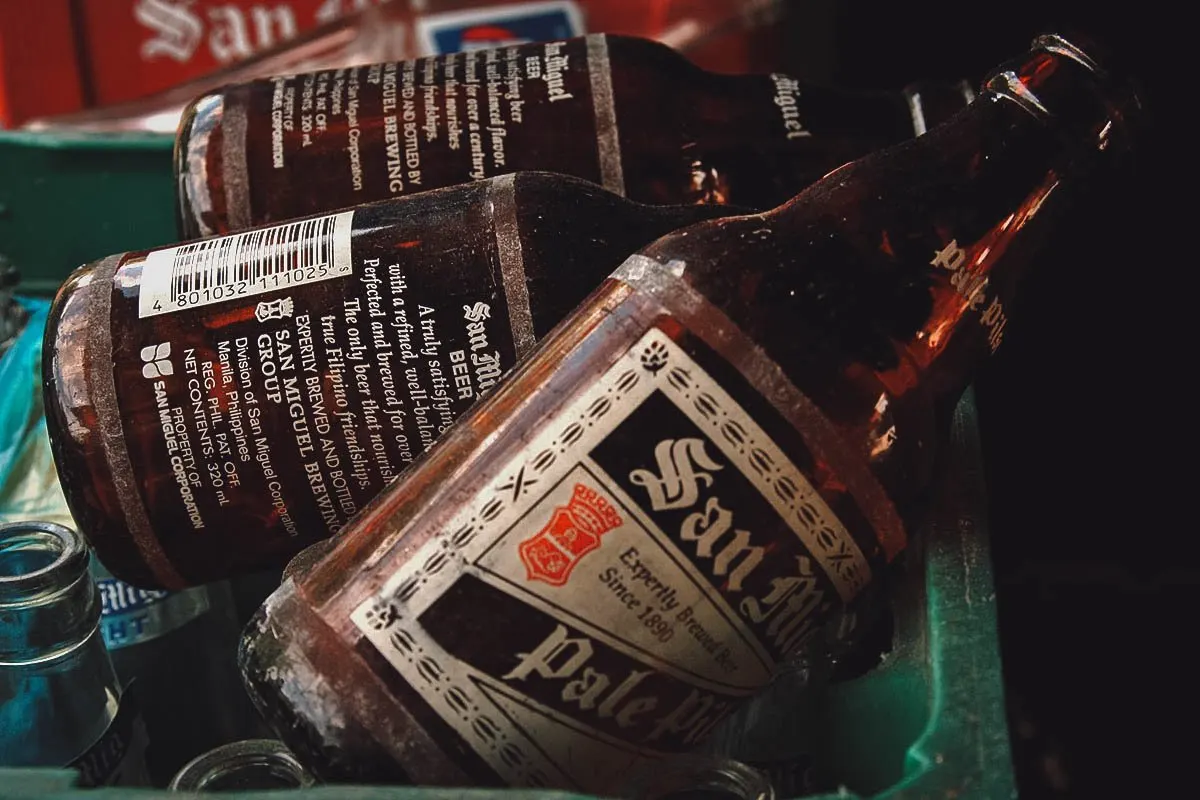
“Best Beer in the World!” by Kamoteus (A New Beginning), used under CC BY 2.0
In the Philippines, you’re either Team Pale or Team Light. Filipino Pale Pilsen drinkers will only drink Pale while San Mig Light drinkers will only drink Light. The Traveleaters are squarely on Team Light.
Admittedly, Pale Pilsen tastes better but it feels much heavier in the stomach.
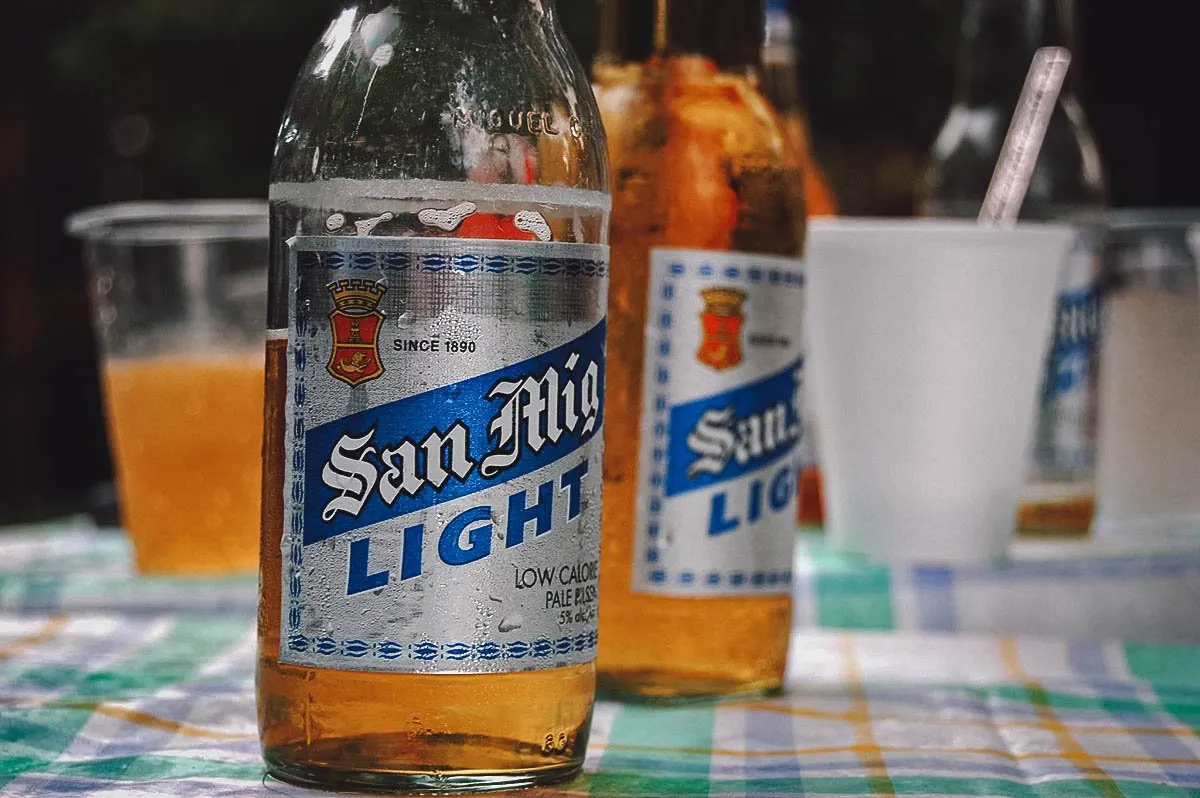
“San Mig Light” by Alvin Chua, used under CC BY 2.0
17. Red Horse Beer
Another popular beer produced by the San Miguel Brewery is Red Horse. It’s a stronger beer that contains about 7% abv.
When Filipinos want to get drunk on beer in the Philippines, they usually do it with Red Horse. It gets the job done.
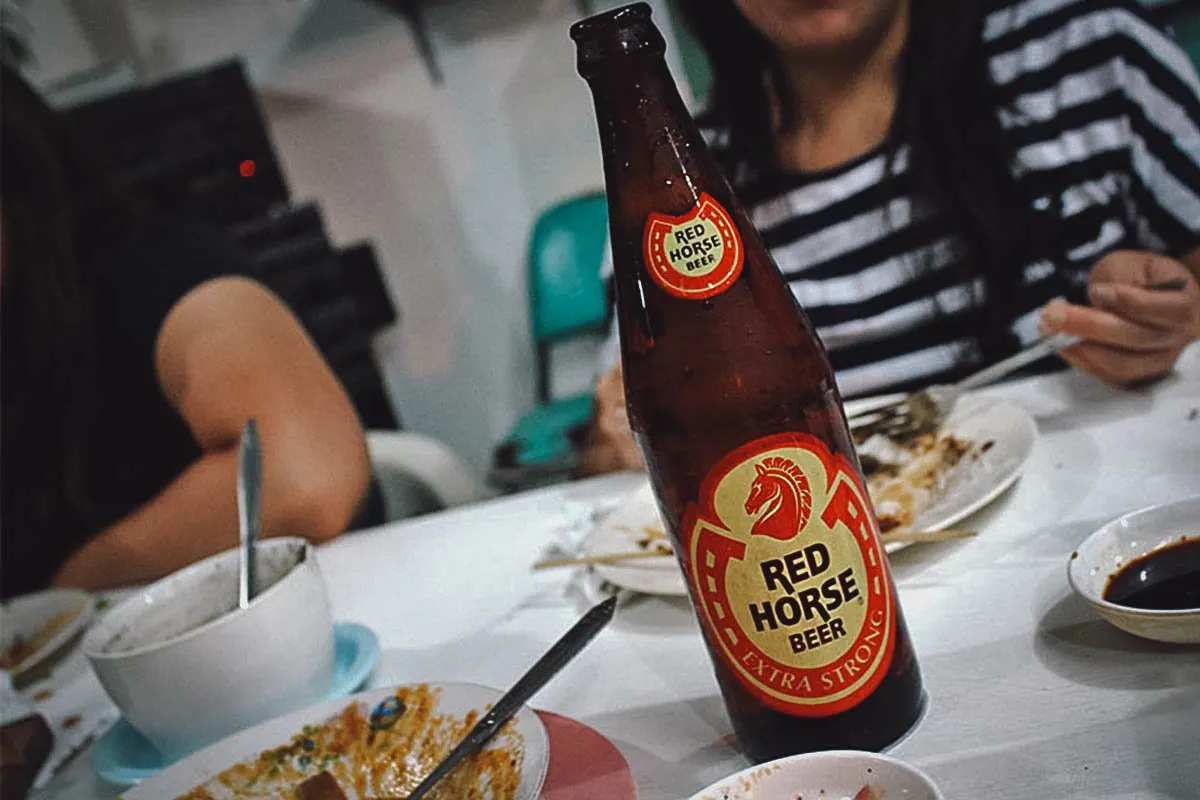
“2013 Angeles Philippines Trip Day 4” by tofuprod, used under CC BY-SA 2.0 / Cropped, removed watermark
18. Tanduay Rhum
Tanduay Rhum is by far the most popular brand of rum in the Philippines. Like San Miguel beer, it dominates the local market and accounts for up to 99% of domestic rum sales in the Philippines. In fact, so popular is Tanduay Rhum that it’s the world’s leading rum brand, ahead of even Bacardi.
This amber-hued elixir has a history of over 160 years and can be purchased from liquor stores throughout the Philippines.
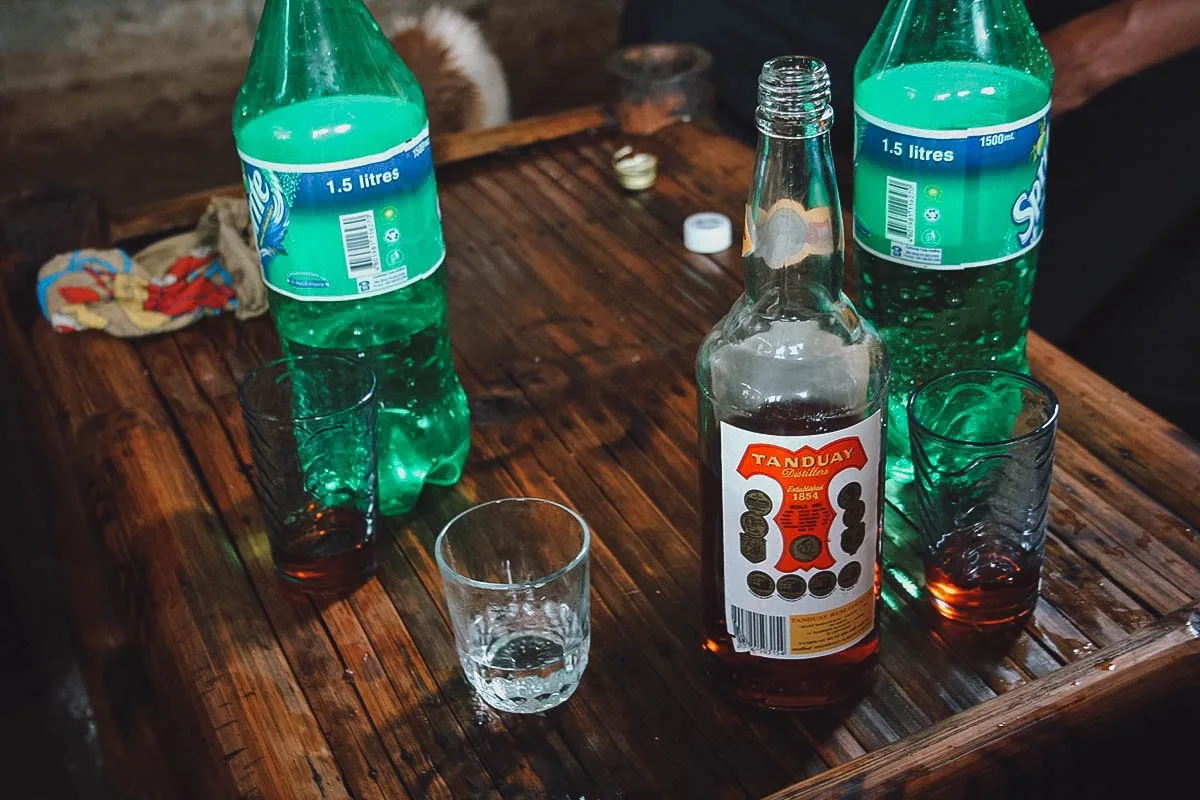
“The one and only Tanduay” by bertconcepts, used under CC BY 2.0
19. Ginebra San Miguel Gin
What Tanduay does for rum, Ginebra San Miguel does for gin. Like Tanduay Rhum, Ginebra San Miguel dominates the domestic gin market. According to Statista, it’s the world’s top-selling gin brand, and it isn’t even close.
Pictured below is a premium bottle of Ginerba San Miguel gin. Click on the link to see what a standard bottle of Ginebra San Miguel gin looks like. You can find both at liquor stores in the Philippines.
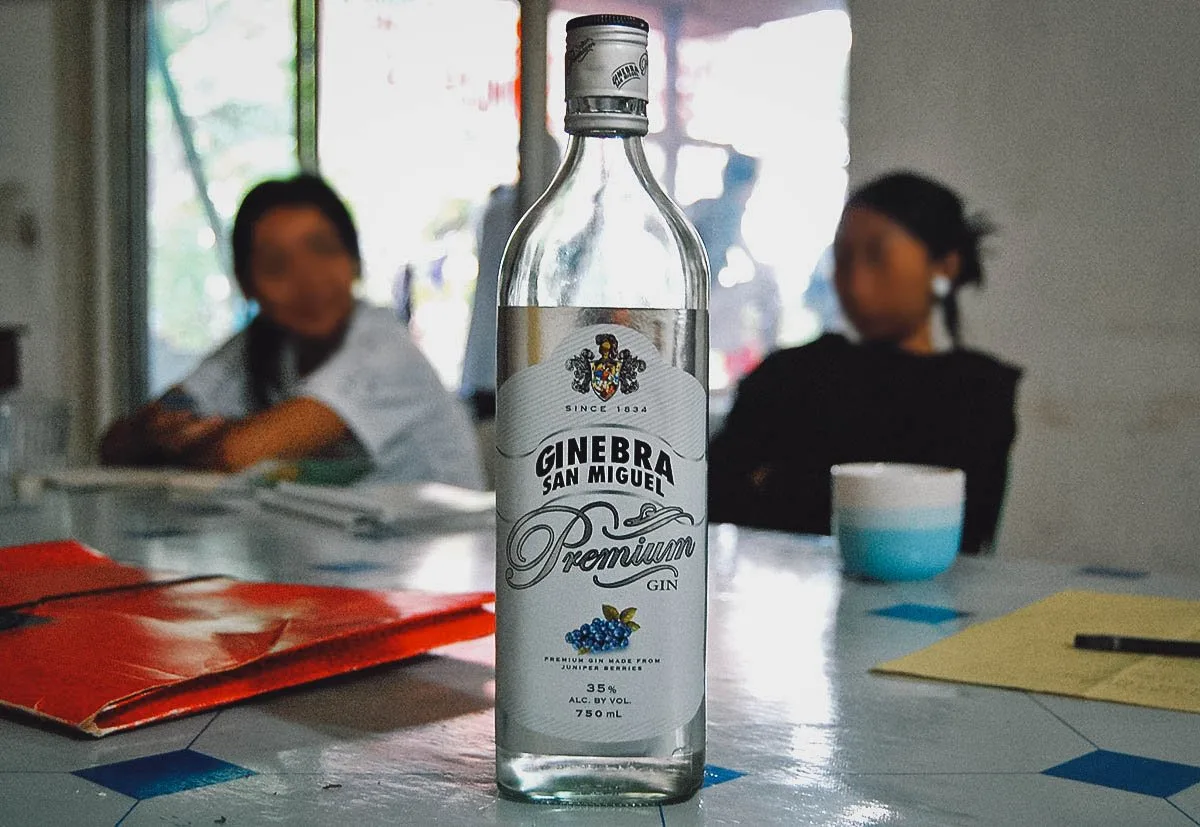
“Ang Pambansang Ginebra” by Shubert Ciencia, used under CC BY 2.0
20. Weng Weng
If you want a cocktail that will knock you on your ass in the Philippines, then order a Weng Weng. It’s the Filipino version of a Long Island Iced Tea. It’s typically made with scotch, rum, bourbon, brandy, vodka, and tequila mixed with orange juice, pineapple juice, and a dash of grenadine.
There are two theories as to how this potent cocktail got its name. One, it was named after Ernesto de la Cruz, a diminutive Filipino action star from the 1970s known by his screen name “Weng Weng”. Two, it’s named after the Filipino slang term for getting utterly shit-faced, which is also “weng weng”.
Whatever its origin, be careful when you order this drink. We’ve had it in Boracay many years ago and we still don’t remember how we got back to our hotel.
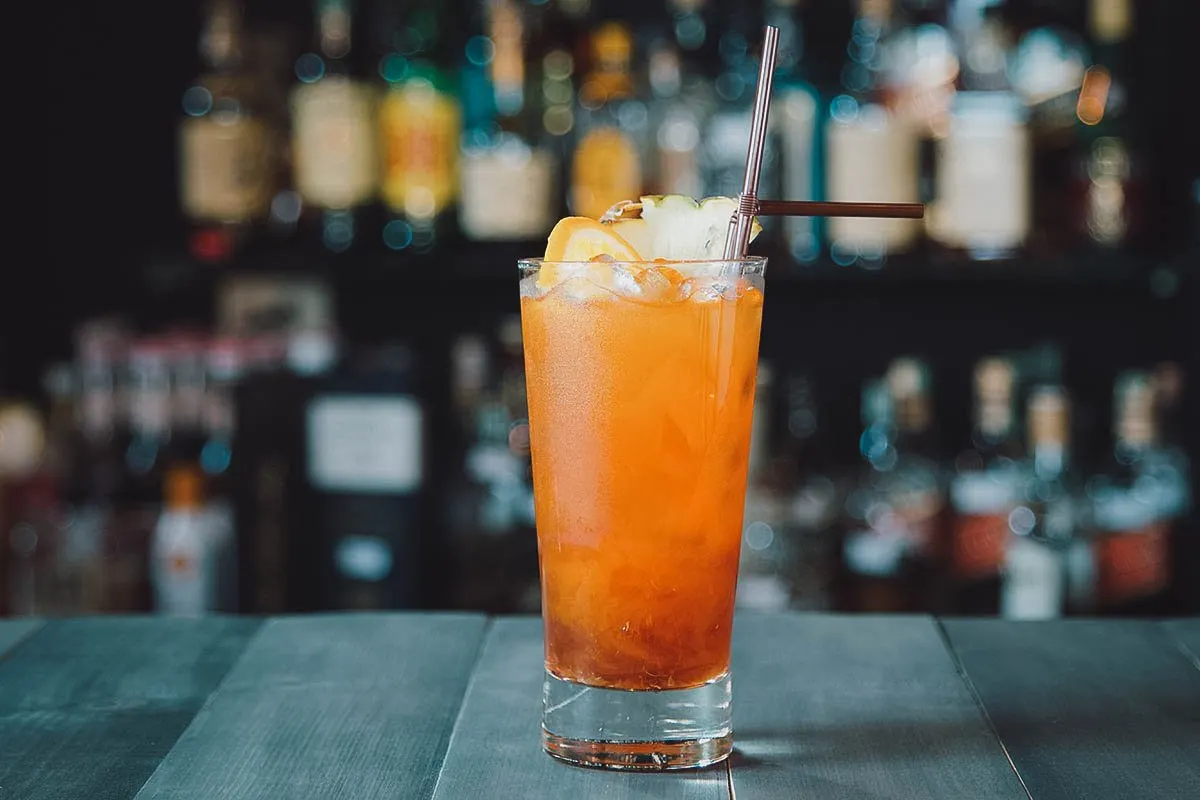
Photo by Joey_Danuphol
FINAL THOUGHTS ON FILIPINO DRINKS
Filipino food is having its day in the sun but Filipino drinks are definitely worthy of your attention as well. I wanted to cap this list at twenty but you may want to look for other popular Filipino drinks like dalandan juice, buko salad drink, and Filipino iced tea.
I’ve never heard of (let alone tried) many of them but depending on where you go in the Philippines, you can find a lot of lesser-known regional alcoholic drinks like bahalina, kinutil, and tuhak. Some of them are quite interesting with strong roots in the local culture.
In any case, I hope this article on Filipino drinks was as enlightening for you as it was for me. I grew up with these drinks but like many Filipinos, I often take them for granted. Reading about them definitely gives me a better understanding and appreciation for our local culture and cuisine. Mabuhay!
Unless otherwise noted, stock photos via Shutterstock. Stock photos processed in Photoshop and Lightroom.


Leah Cabral
Sunday 1st of October 2023
Shembot
Halo halo
Mais con yelo
Iced tubig
Reggie
Sunday 19th of February 2023
Very interesting articles. Nice to know..
Apolinario
Wednesday 15th of February 2023
Walang Ube Cream Liqueur???